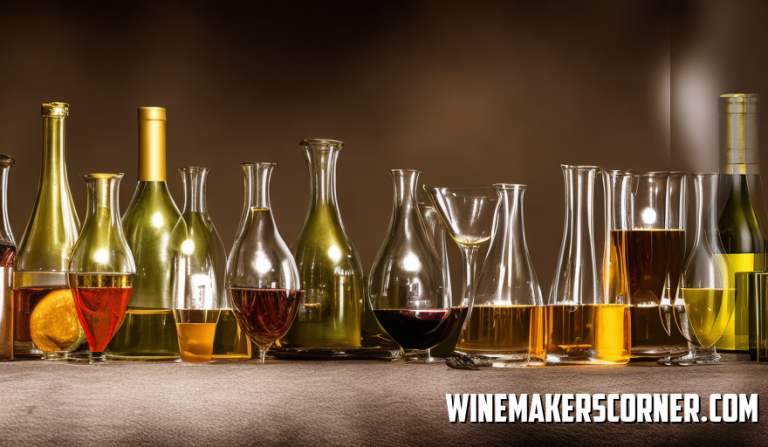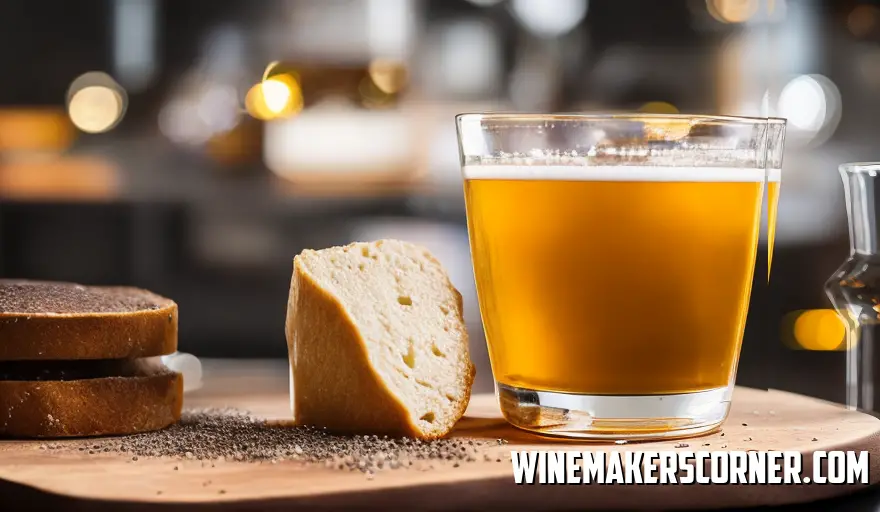Envision yourself wandering through an idyllic vineyard at sundown while basking in its picturesque grandeur. Rows upon rows of vines stretch out before you, glowing radiantly under the setting sun’s brilliant hues. The air is richly fragrant with ripened fruits, teasing your senses with an intoxicating taste on its way.
However, before savouring every sip of wine’s heavenly elixir derived from these blessed grapes – their transformation begins in primary fermentation – an intricate process imbued with enigmatic sophistication.
In this exciting exploration ahead- welcome aboard dear oenophiles-,we’ll unfurl some secrets behind picking just-the-right yeast for sparkling vino by mastering temperature management, executing nutrient management and experimenting with oxygenation techniques amplified for heightened flavour complexity. Even more, we’ll fearlessly tackle those challenging sugars and tannins alike. No worries whatsoever in case of any hurdles en route; we have an arsenal of resourceful troubleshooting tips to ensure your fermentation chugs flawlessly.
Take a grip on your cherished wine-glass and join us in pursuit of wine-making perfection as we plunge into the swirling vortex of chemistry and creativity that practices miracles upon humble grapes, presenting before you liquid gold.
Understanding Primary Fermentation: The Basics
Primary fermentation serves a critical role in transforming grape juice into wine by converting sugar into alcohol through yeast. It requires using high quality grapes to initiate fermentation since naturally occurring yeasts on their skins are crucial participants in this process. Once the grapes are crushed their juice creates “must,” which serves as nourishment for yeasts essential during primary fermentation.
Temperature control plays an integral part in regulating primary fermentations success since higher temperatures speed up fermentations yet result in less favorable flavors while lower temperatures lead to slower but cleaner fermentations with fruity aromas; thus controlling temperature optimally proves critical during this phase. To enhance primary fermentation further stirring helps incorporate oxygen vital for yeast growth and multiplication more movement of must improves yeast activity. On the other hand excessive oxygen exposure may lead to unwanted oxidation or spoilage- hence striving for moderation proves ideal when stirring must.
Measuring specific gravity (SG) indicators during primary fermentation progress aids you in determining when fermenting ends or modifications needed; hence monitoring SG remains crucial throughout this stage.
Finally choosing an appropriate yeast strain offers the final touch to achieving superior wine since each strain has unique flavor profiles and fermentative properties that require careful selection for desired characteristics to stand out in your final product. In summary: Primary fermentation lays a foundation for excellent wine production; from grape selection to regulating temperature stirring techniques through yeast strain choice- understanding and optimizing these aspects could transform your winemaking producing remarkable wines that meet even the most distinguishing palates’ preferences.
Choosing the Right Yeast for Your Wine
Making a careful choice regarding which yeast you use during winemaking is crucial because this microscopic organism has such an influential role in primary fermentation process; it considerably influences the aroma and taste of your finished product. There are various types of yeasts available; each one boasts different qualities that can affect wine flavor.
Selecting the right strain requires consideration of several critical factors:
– Grape Variety: Yeasts offer distinctive flavors to specific grape varieties.
For example, selecting a yeast strain that enhances Chardonnays natural buttery and fruity tones is essential when making this type of wine. – Desired Style: Different wines call for distinct styles. Are you planning to produce dry or sweet wine? A crisp white or full bodied red?
Each yeast type will lend a unique flavor profile to these styles. – Fermentation Temperature: Yeast prefers different temperatures; some thrive in colder temperatures suitable for whites and rosés while others perform better in warmer conditions preferred by reds. – Alcohol Tolerance: High quality wines demand robust yeasts that can handle alcohol well without stopping fermentation. Once you have reduced all possible options based on these four crucial variables mentioned above its time to research each strains specific attributes carefully to determine which one aligns with your goals.
Trying different yeasts first on smaller batches rather than jumping straight into large scale production is encouraged and enables room for refinement.
In summary selecting the proper yeast isn’t an easy decision but getting it right is crucial concerning primary fermentation process during winemaking.
By considering grape variety, desired style, fermentation temperature, alcohol tolerance when choosing a yeast strain will provide you with valuable insights into unleashing the full potential of your accomplished product.
Temperature Control During Fermentation
To create a truly great wine controlling the temperature during the fermentation process is essential. However this can be quite tricky even for experienced winemakers. Optimum results depend on striking just the right balance between keeping it neither too hot nor too cold — a delicate process that requires detailed attention and observation of how fermentation works.
As yeast consumptions sugar to make alcohol more heat is generated within the fermenting vessel. But excessive heat can lead to troubles such as stopping or slowing down of the process altogether while low temperatures may result in an incomplete or prolonged cycle. To get your wines’ best qualities its important to maintain primary fermentation at around 60-75°F (15-24°C) for most types. For white wines that offer delicate fruity or floral aromas cooler temperatures ranging from 50 60°F (10 16°C) may work best keeping these aromas preserved instead of being lost in higher temps which would not do them any favor at all! Meanwhile red wines would tend toward slightly warmer ranges — about 70 85°F (21 29°C) — primarily due to their color compounds extraction requirements and need for tannins from grape skins which play an essential role in enhancing structure and depth.
Producing an exceptional wine requires a deep understanding of your preferred grape varietys distinct characteristics and maintaining optimal temperature consistency throughout its creation process. By following these critical guidelines you’ll be able to produce a standout vintage with ease. Wishing you all the best on your journey – cheers!
Nutrient Management for Optimal Fermentation
Nutrient management is critical in achieving optimal balance for producing robust yeast activity during primary wine fermentation. This balance leads to an aromatic and characterful glass of wine that satisfies taste buds delightfully. Every experienced winemaker comprehends this aspect since overlooking it leads to sub par final products resulting from sluggish or stuck fermentations. Therefore let us demystify the art of skillful nutrient handling together! Nitrogen takes center stage in driving yeast growth during primary fermentation – however not all nitrogen sources yield equal contributions; assimilable nitrogen (YAN) originating from ammonia and amino acids carry substantial significance for upholding optimal yeast health vital throughout the entire process.
Monitoring YAN levels pre fermentation is essential since excessively high or low levels pose undesirable outcomes of off flavors or slowed fermentations respectively.
Vitamins and minerals also command significant importance in maintaining rigorous yeast vitality throughout every stage of fermented product production. Zinc sulfate, thiamine (vitamin B1) niacin, calcium pantothenate, magnesium sulfate come as some essential components whose quantity should never dwindle since shortages lead to complete termination of yeast activity. The key to effective nutrient management lies largely in measuring YAN levels before fermentation via straightforward test kits or engaging professional lab services conveniently available. Upon acquisition of adequate information commercial nutrient formulations exclusively formulated for wine fermentation should be cautiously introduced at specific stages for optimal results.
Controlling temperature during primary fermentation cannot be left to chance since it affects the nutrient uptake by yeast cells – high temperatures increase nutrient requirements which need immediate adjustments in adherence to specific winemaking processes and conditions. To achieve a faultless primary fermentation, nutrient management is crucial. A comprehensive understanding of the role nitrogen, vitamins and minerals play in yeast health and thorough monitoring of YAN levels throughout the process are significant factors contributing to an efficient fermentation. As a result of optimizing these conditions, you can expect a wine with enhanced flavor that awaits everyone’s enjoyment.
Oxygenation Techniques for Improved Flavor
The primary fermentation stage of winemaking is critical because that’s where its quality and flavor originate. Oxygen has a vital role here: A lack thereof will result in dull wines lacking character; too much exposure could spoil everything later on down the line! By using specific methods like gentle punch-downs that break up grape skins (forming caps atop fermenting juices), you can expose developing wines safely while promoting yeast health through increased extraction of flavors from grapeskins without disturbing microbes’ balance needed for natural fermentation.
Monitoring and Adjusting Sugar Levels
In winemaking, one critical stage that requires utmost attention is primary fermentation; unfortunately though many enthusiasts and home winemakers tend to overlook this aspect’s importance when monitoring and adjusting sugar levels fermenting grapes achieve balance ultimately resulting in high-quality wine.
Yeast plays an enormous role throughout this process: converting sugars into alcohol while producing carbon dioxide gases Alcohol content relies heavily on a balance of sugar, whereas too little sugar causes weak alcoholic wines while too much hinders yeast’s activity, leading to product “stuck fermentation” or overly sweet end products.
To achieve the perfect balance in sugar contents use of Hydrometer to monitor the must’s specific gravity is necessary.
At the beginning of primary fermentation, aim for a target specific gravity between 1.090- 1.100 or 22-24° Brix, decreasing gradually as yeast consumes sugars during the fermentation process. If nature doesn’t provide the ideal weather conditions for grapes leading to low grape sugar levels resulting in less potential alcohol levels than wanted then Chaptalization, adding concentrated grape juice or additional sugar could help counteract it.
In contrast, if the must contains excessive sugars(large specific gravity above 1.120), saltwater dilution till regulation could prove useful.
Temperature also plays a critical role in primary fermentation and controlling it would affect yeast activity either by accelerating at higher temperatures or slowing down at lower temps; therefore keeping temperatures below 70°F (21°C) for reds and cooler(65°F or 18°C)for white wines will promote optimal controlled fermentations that won’t undermine yeast cells’ productivity.
One important aspect of making great wine is ensuring that the fermentation process goes smoothly. By regularly stirring the must you can prevent unwanted off flavors and ensure even distribution of yeast and nutrients.
Its a simple step that can have a huge impact on the final product. In addition monitoring sugar levels during primary fermentation is key to producing a well balanced delicious wine. To do this use a hydrometer to keep tabs on specific gravity and intervene with chaptalization or dilution as needed.
Optimal temperatures are also important for success in fermentation.
By taking these steps you can increase your chances of producing a happy must and ultimately creating a great bottle of wine.
Managing Tannins and Phenolic Compounds
Wine production’s primary fermentation phase stands out as the initial step where grape juice undergoes transformation into luxurious wine. Managing two crucial aspects: Tannins and Phenolic compounds becomes unavoidable as they play a critical role in determining necessary features like taste,color & mouthfeel of your finished product.A balance between these elements throughout this vital stage becomes necessary to avoid resulting in lackluster wines that fail to retain depth or overly acrid counterparts resulting from too much Tannin content.
Managing Tannin appropriately requires careful analysis of Grape selection founded on inherent levels’ variation per variety.Riper grapes yield ideal results, softening the tannins resulting from striking a balance during this process. Employing techniques like Cold soaking coupled with specialized enzymes in regulating Grape solids contact in fermentation can help ensure desired phenolic extraction rates to balance wine outcomes.Additionally, temperature variation also plays a critical role, warmer temperatures extract higher phenolics levels than cooler ones.
Finally, post-fermentation treatments stand out as an effective technique in achieving balanced Tannin and Phenolic compounds. You can use fining agents or age barrels of your choice while preserving your brand’s unique personality or style to manage Tannin levels efficiently.
In conclusion: Managing Tannins and Phenolic compounds during primary fermentation require skillful implementation founded on experimentation combined with knowledge and patience. The Resultant Output would delight the senses and withstand time tests perfectly! I kindly suggest that we mix and blend the ingredients together, allowing the extraordinary transformation to take place.
Troubleshooting Common Fermentation Issues
Winemaking is an art and science that requires attention to detail; navigating through the primary fermentation phase can be daunting, with unexpected challenges popping up along the way. As enthusiasts seeking excellence at every turn its crucial to arm ourselves with knowledge on how best to troubleshoot such issues. Stuck fermentation is one of the common frustrations among winemakers who have seen yeast fail in converting all sugar into alcohol due to nutrient deficiency or fluctuating temperatures.
Adding yeast nutrients or stabilizing temperatures remains a practical solution here.
Excessive foaming during fermentation can be another hurdle but with the simple application of anti-foaming agents during vigorous fermentation this situation becomes navigable while still preserving your wines original flavor. Odors emanating from fermenting wines are not uncommon as they indicate risks of inadequate sanitation protocols or bacterial infections. Thus timely cleaning and contamination eradication are paramount for success here.
The last hurdle worth discussing involves unwanted off flavors occasionally experienced by even seasoned winemakers these could arise from oxidation or spoilage yeasts whose effects can be mitigated by keeping proper seals and practicing appropriate urbanization practices.
In conclusion enhancing our wines’ primary fermentation process involves preparedness for possible challenges while employing effective solutions as needed. Acquiring troubleshooting insights helps us explore triumphantly through the unique world of winemaking!




